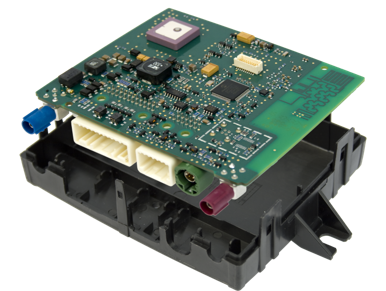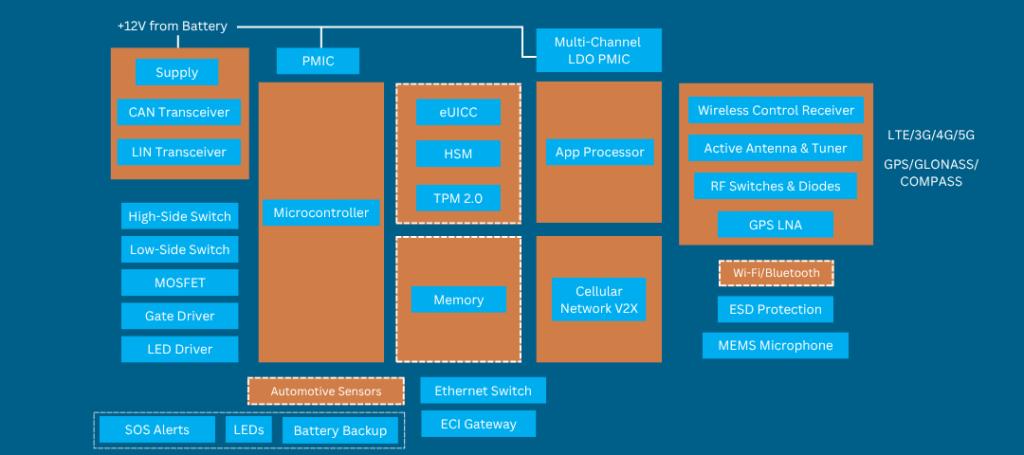Telematics Control Unit
In today’s era, the automotive industry has started to blend completely with environmental information and technologies for navigation, vehicular electronics, and wireless intelligence. Telematics is one such field of change that refers to a wireless communication system that is used to transmit data to and fro between automobiles. In general, it refers to the use of onboard diagnostics and the Global Positioning System (GPS) in monitoring the movement of any asset such as a vehicle or machinery. The info transmission mediators in this case are back-office systems that retrieve and push required data between vehicles via a matrix of mobile and satellites or a Telematics Control Unit (TCU) that works on such technology, where data can be related to weather, stock market, maps, location, vehicle speed, engine data, connection quality, position, acceleration, battery voltage, oxygen sensor, transmission fluid, etc.
A TCU is an embedded device linking the automobile’s subsystems to particular cloud storage and even other vehicles via the Vehicle-to-Vehicle (V2V) and Vehicle-to-Everything (V2X) wireless technology that runs on data and control buses. Another great feature that it offers is in-vehicle networking that may occur through Bluetooth and Wireless Fidelity connections and even VoIP eCalls. Its basic components consist simply of a Telematic Control Module, a microcontroller, mobile networking and storage units, navigation system, electrical signal processors, and an external communication unit. Custom telematics software is useful for sending crash notifications, tolling, and vehicle tracking. It connects people, vehicles, logistic operations, processes by enhancing safety, efficiency, and reducing maintenance costs through notable insights. It records vehicle speed, fuel consumption, tire pressure and other details as well as provides visualization of such insights for improving driving habits.

Service Offerings
Our TCUs will enable and support your in-vehicle, V2V and V2X communications through improved sensing processors, noise reduction, and vehicle diagnostics. Data transmission between automobiles becomes completely reliable and swift with our enhanced security and on-board connection protocols.
So much so that enabling fleet management and handling the vehicle’s operation become comparatively easier and safer with imbibed safety regulations. Gone are the days of long hours of maintenance diagnostics and long-term planning of inspections, for our customized telematics solutions which can track service records, checkpoints of guaranteed recovery, engine usage hours, and guide you to root causes of operational or communication failure, if not avoid, cutting your overall costs.
Technical Specifications
S. NO. | INPUT DESCRIPTION | SPECIFICATION |
1 | Wireless | GNSS, LTE with Fallback, Wi-Fi, BT, BLE |
2 | Battery | Internal Aux battery |
3 | Input/Output | Analog input x 2, digital input x 2, Digital output x 2, Emergency switch x 1 |
4 | Serial Communication | CAN Interface / RS232 |
5 | SIM Type | Internal SIM |
6 | IP Rating | IP 65 Rating |
7 | Operating Voltage | 9-60 VDC supply |

Our Implementation Practices
Software-as-a-Service
SaaS-based custom telematics software is pre-built, ready-to-deploy, and cost-efficient, especially for small to medium fleets, where these models include regular updates, security patches, and customer support through a subscription plan.

Transforming Mobility: AI-Powered Telematics Control Unit by KritiKal
- KritiKal boasts decades of experience in developing complex combinatorial hardware and software solutions like these units for some major companies across the globe.
- Our advanced customized telematics solutions provide real-time insights into the battery monitoring system, transmission fluid, engine data, and connection quality, enhancing overall vehicle performance.
- We design standalone TCUs that are compatible with any Engine Control Unit (ECU) and arrive with attractive features such as calling over VoLTE options, radio-frequency network communications control through LTE, Wi-Fi, Bluetooth, integrated Inertial Measurement Unit (IMU) and so on.
- We integrate AI models for predictive analytics and real-time decision-making using high-quality training data for autonomous vehicle data to enhance accuracy and performance.
- We employ modular architecture and cloud-ased custom telematics software for scalability and design user-friendly, mobile-optimized dashboards with feedback mechanisms.
- We can also assist you in production-level telematics hardware designing for developing smart vehicles with improvised Controller Area Network (CAN). We integrate sensor interfaces (with GPIO, analog sensors for protection and conditioning) as per automotive market standards.

FAQs
With rapid technological change in the automotive industry, vehicles are likely to be converted into connected and autonomous vehicles in a future that is not so distant. Stay on par in the competitive market with customized telematics solutions that link automobiles to cloud storage and other vehicles.
A telematics control unit in car offers some very important features such as information on GPS, location, vehicle diagnostics, emergency services, V2X communications, and so on.
Our Telematics Control Unit can be customized and integrated with a wide range of vehicles such as cars, electric vehicles, trucks, etc., as we modify them to adapt according to your specific business needs.
The overall costs and project timeline for developing a customized telematics control unit in car may vary according to your needs, which can be further discussed by contacting us.




 Global
Global  United States
United States 